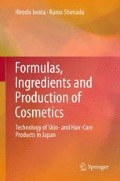Abstract
This chapter describes the practice of designing cosmetics formulations and gives examples of actual formulations. Toilet soaps have long been manufactured by saponifying natural oils and fats with alkalis, such as sodium hydroxide. Today, they are mainly produced by neutralizing fatty acids. Shampoos mainly consist of anionic, amphoteric and cationic surfactants, thickeners, and bubble stabilizers. The properties and combinations of the ingredients determine the viscosity and the feel of use of the product and thus should be carefully investigated. Hair conditioners, rinses, treatments, and packs consist of similar constituents, but hair treatments and hair packs also contain proteins, amino acids, moisturizing ingredients, and/or other efficacious constituents in general to repair damage. Skin creams should be designed so as to achieve the aimed sensory characteristics, i.e., for making moisturizing or light cream. The sensory characteristics of creams are determined by the oily components, emulsifiers, polymers, glycols, product form, and viscosity. The sensory characteristics and viscosity can be estimated from the alkyl groups of the oily components and surfactants. Leave-on hair care cosmetics are applied directly on hair and are not rinsed off, and thus the sensory characteristics of the constituents are directly felt. It is thus important to have thorough knowledge of the sensory characteristics of the ingredients to be combined such as oils, glycerols, and polymers. Cosmetics mainly consisting of oils are produced by combining carbohydrates, vegetable and animal oils and fats, waxes, esters, higher alcohols and nonionic surfactants, and adding coloring agents, scenting agents, and efficacious ingredients. Facial toner should be formulated so as to moisturize, soften, firm up, brighten, and smoothen the skin and give a moisturized feeling.
Access this chapter
Tax calculation will be finalised at checkout
Purchases are for personal use only
Author information
Authors and Affiliations
Rights and permissions
Copyright information
© 2013 Springer Japan
About this chapter
Cite this chapter
Iwata, H., Shimada, K. (2013). Practice of Designing Cosmetics Formulations. In: Formulas, Ingredients and Production of Cosmetics. Springer, Tokyo. https://doi.org/10.1007/978-4-431-54061-8_5
Download citation
DOI: https://doi.org/10.1007/978-4-431-54061-8_5
Published:
Publisher Name: Springer, Tokyo
Print ISBN: 978-4-431-54060-1
Online ISBN: 978-4-431-54061-8
eBook Packages: Chemistry and Materials ScienceChemistry and Material Science (R0)

